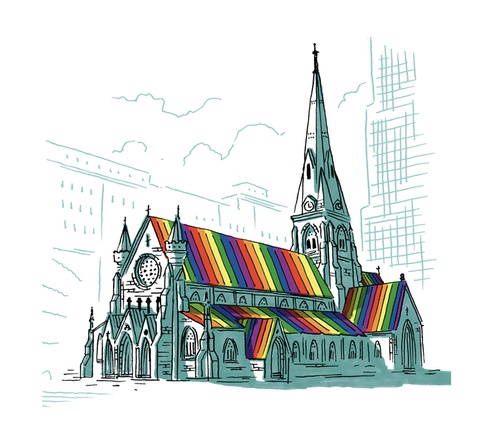 Illustration by Patrick Doyon.
Illustration by Patrick Doyon.
The Spirit and the Flesh
The role of the body in Christian worship has historically inhabited an ambiguous space between sacred and sinful.
The aluminum-plated spire of Christ Church Cathedral rises high above St. Catherine Street, though not quite as high as the shopping centres that flank it on both sides. First built on Notre-Dame in 1814, destroyed by fire and rebuilt further north in 1859, the church is older than Canada itself. Inside, high ritual and traditional Anglican liturgy are enacted in front of intricate reredos, the stone screens behind the altar. At one end of the church, a painted carving proclaims “Praise Ye The Lord.” At the other end hangs a rainbow flag.
As the Sunday Sung Eucharist begins, a small choral group passes by the flag as it makes its way down the central aisle. The building is filled with the sound of Olivier Messiaen’s “Les Anges” from “La Nativité du Seigneur.” Light coming through the Cathedral’s stained-glass windows splashes soft yellows, reds and blues across the pews.
The traditional liturgical service on offer at Christ Church reveals the hidden physicality of religious ceremony. By allowing the onslaught of “bells and smells” to overwhelm us, we are more easily able to leave the body behind and surrender the spirit to a higher message.
But the careful and solemn ceremonies performed under the Cathedral’s gothic arches and wide timber ceilings appear dramatically different in the company of the long strip of rainbow fabric hanging to the left of the front doors. The flag indicates that this is one of the few churches in Montreal where parishioners can enjoy a traditional service whatever their sexuality, but it also represents an important theological shift, wherein the needs and desires of the body are not hastily dismissed as sin.
During services, the flag becomes a participant—its presence changes the nature of the sacred space. Where parishioners are often de-sexed and disembodied by entering a church, the flag suggests that the demands of the flesh, whether heterosexual or homosexual, are not incompatible with faithful worship.
Though the Anglican Church of Canada has a fairly liberal religious philosophy and a mission statement that emphasizes “greater diversity of membership,” its attitude toward same-sex relationships has been slow to change. In 2003, the bishop of Westminster issued a “blessing” of same-sex union ceremonies, but the practice wouldn’t be adopted in Montreal until 2010, six years after gay marriage became legal in Canada. The ordination of gay clergy, whether married or unmarried, has been a source of contention. But Montreal’s local diocese has decided that there are no canonical impediments to ordinations of gay ministers. Christ Church Cathedral is home to two openly gay clergy members.
The role of the body in Christian worship has historically inhabited an ambiguous space between sacred and sinful. The blood of Christ and the holy virginity of Mary both remind us of the vulnerability of our physical forms, their propensity to sin and their weakness in the face of God’s omnipotence. According to Christian theology, the soul is transcendent and eternal, and our earthly figures are a temporary vessel, and a corrupt, dangerous one at that. At Christ Church, we are presented with the idea that the dichotomy between sinfulness and sexuality can be reconciled.
Please send submissions for this column to [email protected].





